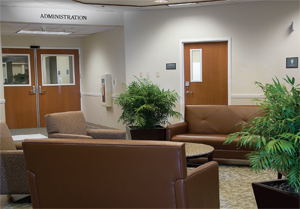| August 2008 |
| In an Era Where Fewer and Fewer Treatment Centers Deal With Managed Care, PaRC Thrives
When he started at Memorial Hermann a few years earlier, the addictions offerings at the non-profit, one of the biggest hospital systems in the nation that this year is celebrating its 100 year anniversary, were a very minor, relatively small part of the system. And the few beds that there were weren’t being completely filled. As is often the case in large med surg operations – and Memorial Hermann is large, with 14 hospitals and almost a million patient visits annually – it appears that addiction treatment had been a bit of an afterthought when Feehery arrived to take control. “Addiction treatment is a very different kind of medical service than med surg,” says Feehery. “And often there’s little understanding of what it takes to build a successful program.” Program Builder And, certainly, there are very big natural synergies between med surg operations and addiction treatment, with data coming recently out of the nation’s community hospital system proving what the addiction treatment industry has long known – that a huge amount of emergency room activity is driven by health problems created by addiction and substance abuse. Receptive to Plan
From just 42 beds last year, PaRC now has just over 200 beds, with a more than doubling of its adult capacity to 90 beds, a new adolescent center with nearly 70 beds and almost 50 beds at PaRC Place, a sober living facility designed to provide a step down continuum of care at the treatment center. A major reason behind the PaRC expansion, and most expansions for that matter, is that Feehery was seeing demand that was far out-stripping his capability to provide services. “Sometimes we had a waiting list 20 people deep,” says Feehery. “And when we went to make referrals for some of these patients elsewhere, we were hearing from them that they wanted to be treated here at PaRC.” Of course, along with the big build out has come big investments, with Memorial Hermann pouring over $6 million into renovations for its PaRC project. And now PaRC, which used to be a tiny portion of the Memorial Hermann medical landscape, sits on its own campus with two buildings and over 140,000 square feet of residential, treatment and administrative space. “We used existing space here at Memorial Hermann for the expansion,”says Feehery, adding that if the PaRC project had been done on a greenfield basis, “it would easily have cost $30 million to complete.” And the new Adolescent Program, which opened its doors earlier this month, was also a function of strong marketplace demand. Says Feehery: “Just like elsewhere in the nation, centers in Texas have been getting out of the adolescent business, and our referral sources were telling us there would be demand for beds if we opened a program.” Managed Care This is, Feehery says, in accordance with the non-profit mission of PaRC to provide affordable services that are highly accessible to ordinary individuals who use their insurance policies as their principal means of accessing healthcare services. In this sense PaRC is bucking the trend in the treatment industry, where on the private side private pay has risen to account for at least 50 percent of industry revenues, according to Treatment Magazine estimates. And while Feehery says that PaRC will continue to rely largely on managed care to fill its beds – he says demand from managed care providers for PaRC services continues to rise – private pay will play a larger role in view of the scale of PaRC’s recent large expansion. “We will be much more aggressive in seeking out the private pay dollar, looking to market our very affordable high quality program nationally,” says Feehery. With fewer and fewer centers doing managed care – 46 percent now vs 54 percent in 1999 – PaRC’s success stands as a remarkable achievement in the annals of recent treatment history. TJ |


 Four years ago, Matt Feehery approached the powers that be at Houston’s giant Memorial Hermann hospital system with a plan for a huge expansion of the medical provider’s Prevention and Recovery Center, PaRC, substance abuse treatment facility.
Four years ago, Matt Feehery approached the powers that be at Houston’s giant Memorial Hermann hospital system with a plan for a huge expansion of the medical provider’s Prevention and Recovery Center, PaRC, substance abuse treatment facility. And what has emerged this year, four years later, is one of the most extensive treatment center build outs and expansions in recent memory, an expansion that has catapulted PaRC almost overnight into one of the largest treatment providers in the nation, on a par in size with big players like The Watershed, Cornerstone New York and Southern California’s Tarzana.
And what has emerged this year, four years later, is one of the most extensive treatment center build outs and expansions in recent memory, an expansion that has catapulted PaRC almost overnight into one of the largest treatment providers in the nation, on a par in size with big players like The Watershed, Cornerstone New York and Southern California’s Tarzana. The success of the PaRC program is all the more remarkable in that it has been done in a payor mix environment where the center gets more than 80 percent of its revenues from the many health insurers with which it has signed discounted managed care deals, United Behavioral Health being the largest.
The success of the PaRC program is all the more remarkable in that it has been done in a payor mix environment where the center gets more than 80 percent of its revenues from the many health insurers with which it has signed discounted managed care deals, United Behavioral Health being the largest.








